Bio Ch 7
1/83
Earn XP
Description and Tags
Membrane Stucture Function
Name | Mastery | Learn | Test | Matching | Spaced |
|---|
No study sessions yet.
84 Terms
All cells have a…
plasma membrane
Plasma membrane functions
To contain the cell’s contents (cytosol, organelles)
To regulate what enters and exits the cell
(Selectively Permeable)
Selectively Permeable
Only certain molecules may pass through the
membrane
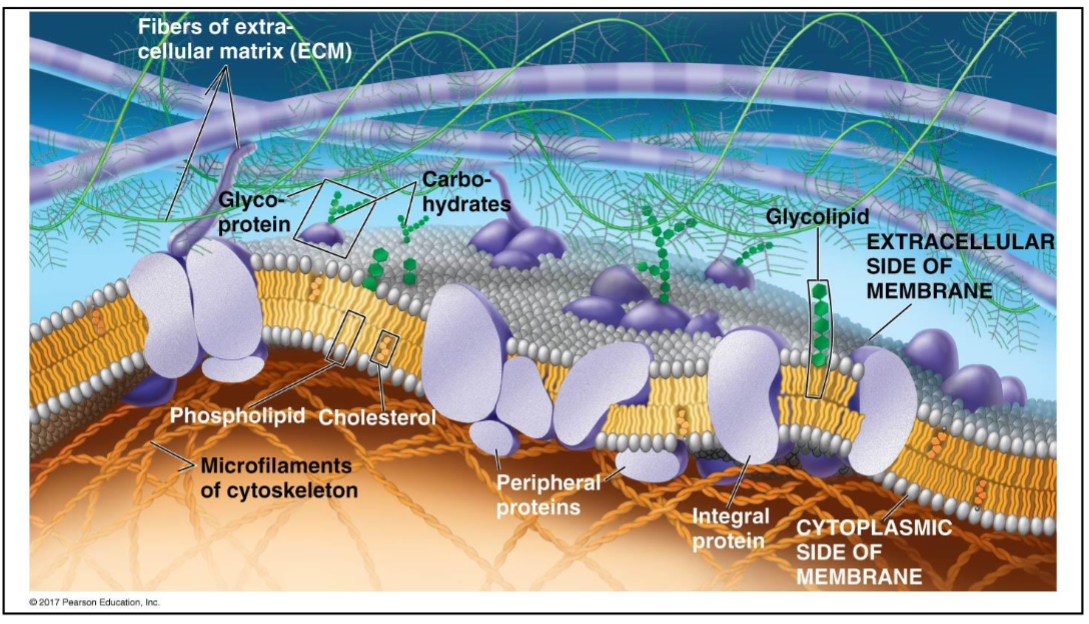
Plasma membrane structure
Phospholipid Bilayer
Cholesterol
Glycocalyx
Proteins
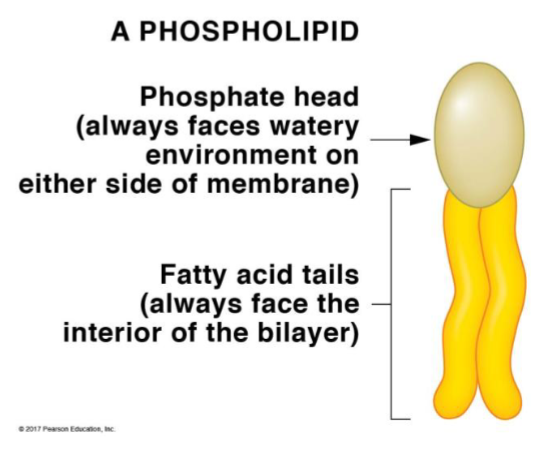
Phospholipids structure
Polar, hydrophilic heads:
• Glycerol + phosphate group
Nonpolar, hydrophobic fatty acid tails:
• Saturated and unsaturated
The Phospholipid Bilayer
Selective Permeability
Prevents large molecules from crossing the membrane
Hydrophobic region keeps out polar and charged molecules
Sugars, ions
What can pass the Phospholipid Bilayer
Prevents large molecules
from crossing the
membrane
• Hydrophobic region
keeps out polar and
charged molecules
• Sugars, ions
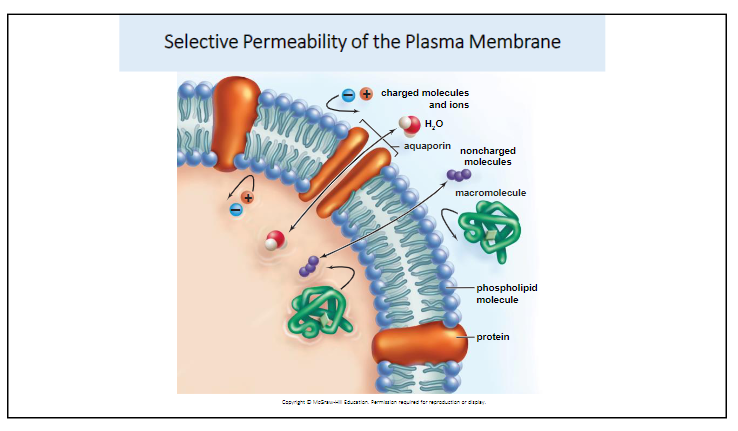
Importance of Selective Permeability
Intake of nutrients
Intake of signals
Excretion of waste
Intake of oxygen/excretion of carbon dioxide
Regulation of ion concentration
***Transport Proteins are needed to allow polar molecules into the cell***
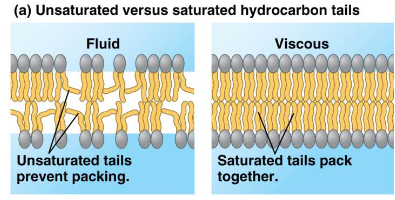
Membrane Fluidity
Membranes with more unsaturated fatty acids remain fluid at
lower temperatures than those with more saturated fatty acids
Plants increase percentage of unsaturated fatty acid tails in…
the fall

Cholesterol
Acts as a patching substance: blocks small molecules from passing
The membrane “fluidity buffer”
Resists changes in membrane fluidity
At low temperatures cholesterol:
Prevents phospholipids from packing too tightly
At high temperatures cholesterol:
Prevents phospholipids from separating
Glycocalyx functions:
Cell-Cell Recognition
Embryonic tissue sorting
Immune system:
• Transplant rejection
• ABO blood type
Glycocalyx membrane carbohydrates
Glycolipids, Glycoproteins
Glycolipids
carbohydrate bonded to lipid
Glycoproteins
carbohydrate bonded to protein
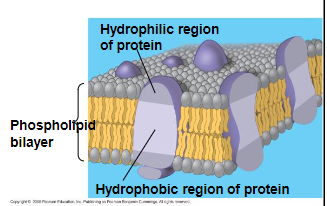
Plasma Membrane Proteins 2 major types
Integral Proteins, Peripheral Proteins
Integral Proteins
Embedded in the hydrophobic region of membrane. Transmembrane proteins
Peripheral Proteins
Bound on the surface of the membrane or the exposed portion of integral proteins
Transmembrane proteins
Span the entire membrane. Many are channel proteins allowing passage of polar molecules
Plasma Membrane Proteins functions
Transport: Allow passage of molecules that can’t cross the membrane
Enzymatic Activity: function in metabolic pathways
Signal Transduction: Receive signals from outside the cell
Cell-Cell Recognition: Important in immunity (Why our bodies reject transplants)
Intercellular junctions: Cells attach in tissue formation or for communication
Attachment to cytoskeleton and ECM: for structure/communication
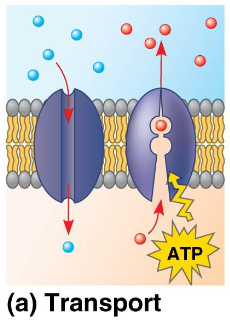
Transport Proteins
Allow certain polar molecules to cross the membrane (They are all specific)
Channel Proteins (no energy needed)
form channels for sugars and certain ions to pass
lined with hydrophilic amino acids
Aquaporins
a channel protein for water
Carrier proteins (some may need energy)
Bind ions/molecules and change shape to bring them across
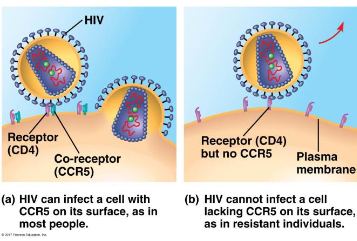
Cell-Cell Recognition
Cells must have compatible cellular proteins for recognition (Often Glycoproteins)
Membrane proteins are important in the immune system bc:
Antibodies and T-cells recognize cells as “self”
Viruses have capability of infecting human cells if viral proteins are compatible with cell protein receptors
Molecular Movement
Molecules are constantly in motion
Speed determines state of matter
Molecules moving fast = Gas
Molecules moving very slow = solid
Molecular movement can be…
directional
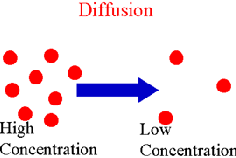
Diffusion
movement of molecules from a high concentration to a low concentration
Passive Transport
Transport of molecules across a membrane requiring no energy
3 types of passive transport
Simple Diffusion
Facilitated Diffusion
Osmosis
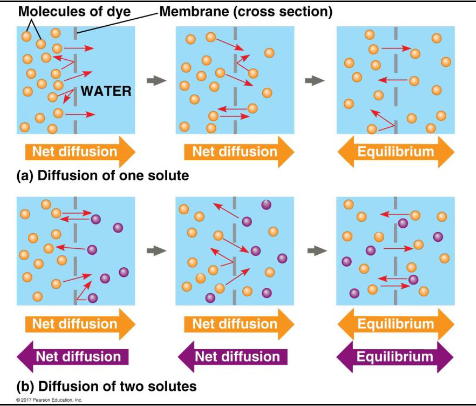
Simple Diffusion
movement of molecules across a membrane from a high concentration to a low concentration
Molecules move along their own concentration gradient, independent of others (T/F)
True. (Difference between the high and low concentrations)
Drives diffusion
concentration gradient
Diffusion Across a Membrane
Facilitated Diffusion
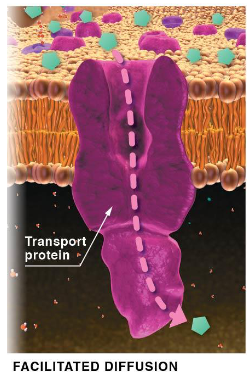
Facilitated Diffusion
Diffusion of a molecule through a channel or carrier protein
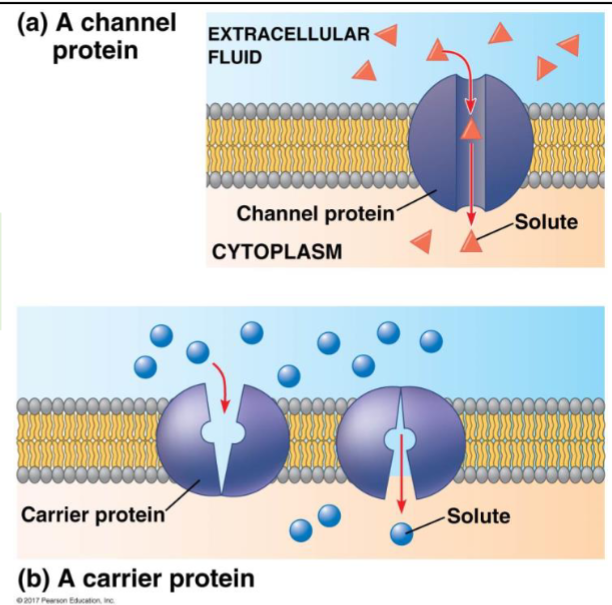
Facilitated diffusion examples
Aquaporins: 3 billion water molecules per second
Glucose Transporters
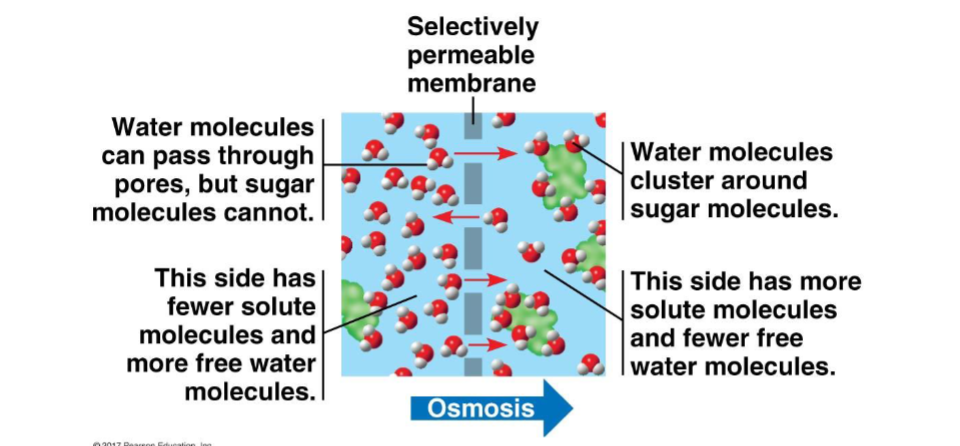
Osmosis
Diffusion of WATER across a semipermeable membrane
Solute
Osmotic Activating Substance (OAS)
Water moves when the solute cannot…
diffuse through the membrane
Water moves in the direction of the…
high solute concentration
At a high solute concentration:
less free water b/c ***Water dilutes the solute***
At a low solute concentration:
more free water b/c ***Water dilutes the solute***
Water moves toward…
the direction of the solute
Water diffuses from high to low concentration…
of itself
Tonicity
The ability of a solution to cause a cell to gain or lose water
Tonicity depends on…
relative amounts of nonpenetrating solutes outside the cell vs. inside the cell
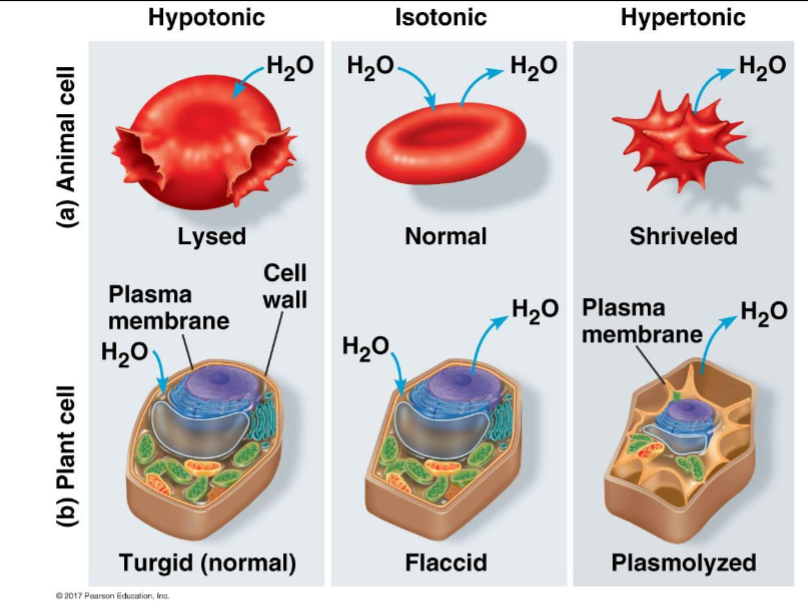
Three types of Tonicity solutions
Isotonic
Hypertonic
Hypotonic
Isotonic solution
Equal concentrations of solutes on either side of the membrane (No net flow of water)
Hypertonic solution
Solution with higher solute concentration
Hypotonic solution
Solution with lower solute concentration
Water moves from a Hyp__tonic to a Hyp__tonic
solution
Hypotonic, Hypertonic
In a Hypertonic Environment:
Animal cells: crenate (shrivel due to water loss)
Plant cells: plasmolyze (Plasma membrane pulls away from cell wall, and the plant wilts)
In a Hypotonic Environment:
Animal cells: lyse (burst due to too much water entering cell
Plant cells: become turgid. Firm and healthy-plant is upright due to pressure on cell wall
In an Isotonic Environment
Animal cells: appear normal. (No net movement of water)
Plant cells: appear flaccid (No net movement of water, so not enough pressure on cell walls to keep plant upright)
Osmoregulation
The control of water balance
Paramecium
contractile vacuole to rid cell of excess water
Organisms which lack cell walls have adaptations to maintain water balance if they live in…
Use of osmosis
Preserving foods! How?
Sugar and salt draw water out of bacteria.
Prevent growth and food spoilage
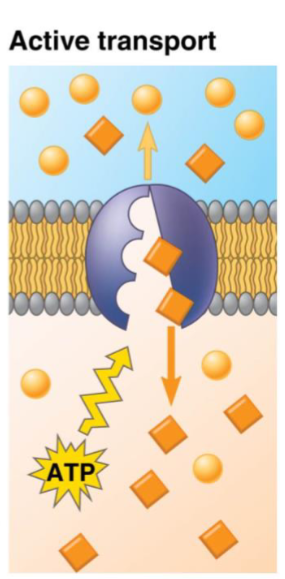
Active Transport
Transport that requires ENERGY
Why does active transport require energy?
•Carrier proteins move molecules against their concentration gradients
From a low concentration to a high concentration
• Requires ATP
Active transport ATP
ATP transfers its terminal phosphate group to power the carrier protein
Membrane Potential
Voltage across a membrane
Electrochemical gradient
Concentration gradient combined with membrane potential
Membrane Potential maintained by
on pumps (electrogenic pumps)
Cytoplasm is negative
-Cations are favored to cross into the cell
Extracellular fluid is positive
-Anions are favored to cross out of the cell
Pumps maintain the charge differential
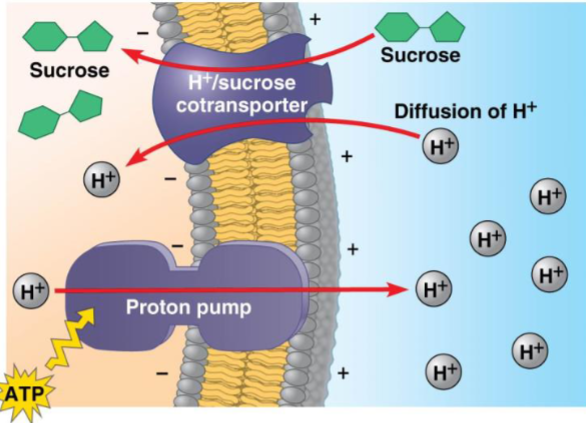
Cotransport
Diffusion of one solute drives the active transport of another solute
How do molecules too big to fit through a channel protein get across the membrane?
Exocytosis and Endocytosis
Exocytosis
Movement of molecules OUT of the cell by fusion of a vesicle with plasma membrane
Endocytosis
Movement of molecules INTO the cell by creation of a new vesicle from the plasma membrane
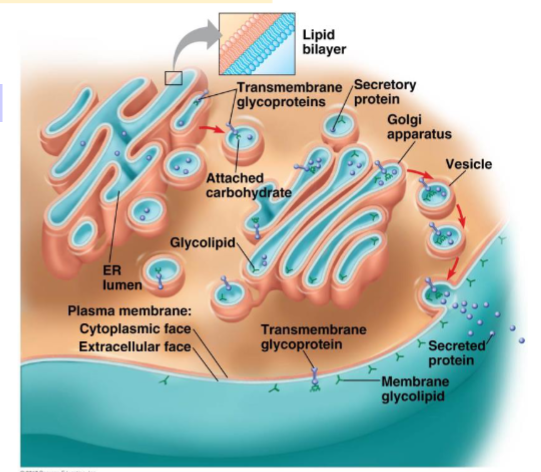
Exocytosis
Transport vesicles fuse with the plasma membrane and release contents from cell
Endocytosis Three Types
Three Types:
Phagocytosis
Pinocytosis
Receptor-Mediated endocytosis
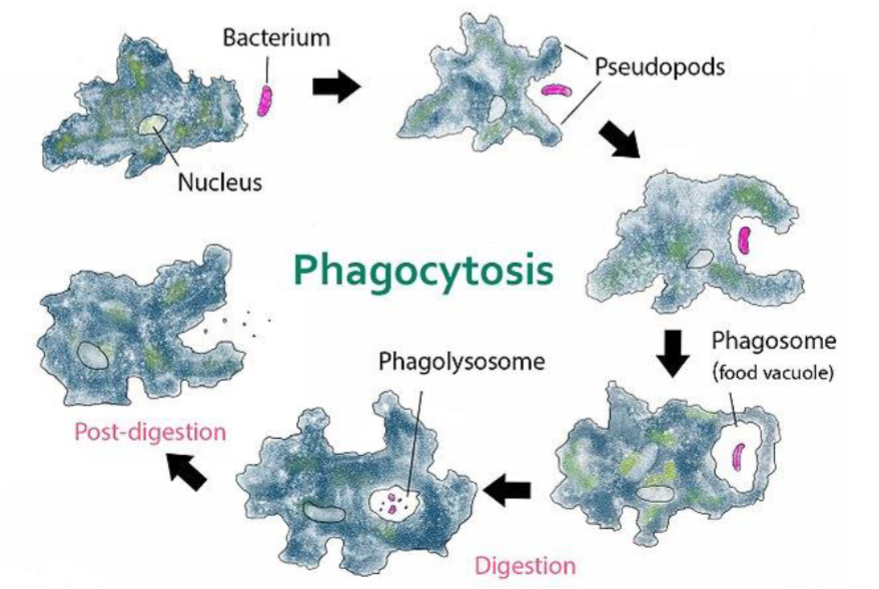
Phagocytosis: “cell eating”
Pseudopodia extend outward to enclose particles into a vesicle
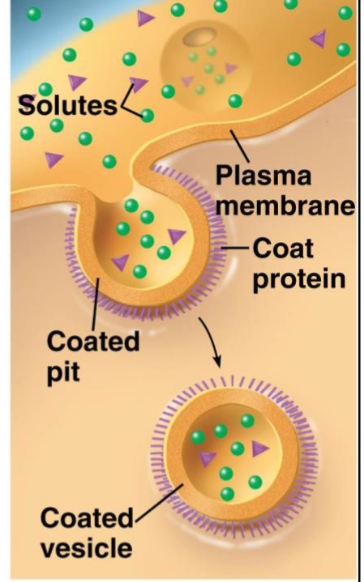
Pinocytosis: “cell drinking”
Plasma membrane invaginates, enclosing extracellular fluid into a vesicle

Receptor-Mediated endocytosis
Receptor proteins bind their ligand, congregate, and are brought into the cell via a coated vesicle